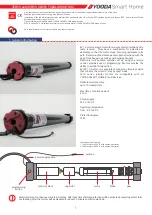
Priming/purging the fuel system
Fuel system needs purging of all air after initial installation and also to clear any small particles picked up
during installation:
1. Disconnect the fuel feed to engine.
2. Place a small container, cloth rag etc that the fuel feed pipe to the engine can be pointed into.
3. Set the trim to low and go to “Info” menu and then travel to “Pump test”.
4. Click on “on” /”off” to start/stop the pump manually.
5. Observe fuel line to engine very carefully and push the off button to stop a couple of seconds
after fuel reaches the rag or container.
6. Now connect the pipe to the engine.
IMPORTANT: The prime procedure should be done only to fill the fuel tube and filter in the case
of a first installation or in case of disassembling of the tubes. It does not need repeating.
Pushing fuel directly into the engine will cause an uncontrolled fire at next startup.
Starting Notes
•
During the start-up ignition phase listen to the engine sound to check for positive sound of
ignition, check looking from the exhaust that the kero is burning, or check for an increase in
exhaust temperature in the display. A small plume of white smoke from the exhaust means that
the fuel is not burning. The fuel is pooling inside the engine. Abort immediately the start.
•
Double check that the engine is not flooded. An extra security measure is to place a manual valve
between the pump outlet and engine, so during the process of filling the tanks or during storage,
fuel cannot arrive to the engine.
•
After a failed start, or whatever condition that could cause that fuel be collected inside the engine
(ie accidental priming), ALWAYS empty the engine of fuel by placing a rag at the engine intake
and tilting the engine nose down. Fuel will exit through intake. Due to the internal engine
construction the fuel cannot exit out through the exhaust.
•
Kerosene can keep burning slowly for a long time inside the engine. This situation can happen
during an aborted start, the start-up sequence is aborted by the user or automatically before the
engine arrive to idle. This can cause the kerosene inside the engine keep burning for long time,
and could destroy the engine or the model.
•
IF START-UP SEQUENCE IS NOT COMPLETED, CHECK FOR FLAME INSIDE THE ENGINE.
•
If there is flame, then set full throttle for over 3 seconds to engage the starter and blow out the
flame. USE SHORT BURSTS OF STARTER. Using the starter for long time can overheat and
destroy the starter motor. In the case that the start-up procedure has been aborted due to starter
failure or the engine has jammed, then it will be necessary to apply the CO2 fire extinguisher.
•
A white smoke plume from the engine is a good indication here; mean that there is no fire inside.
Page 45









































